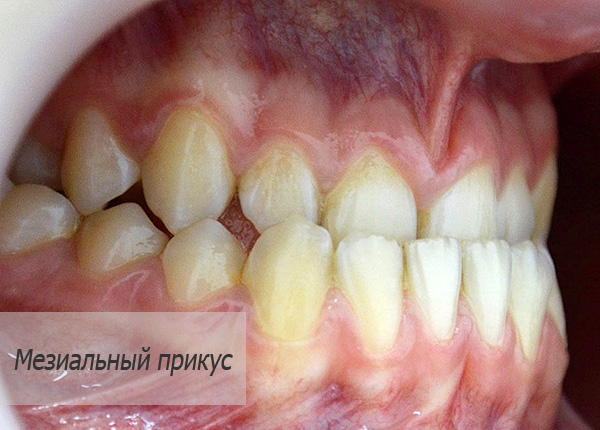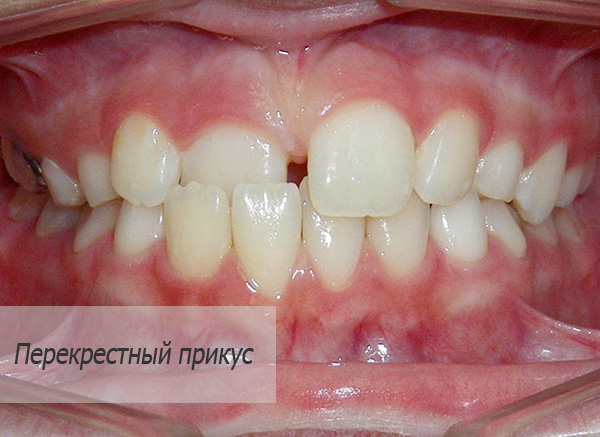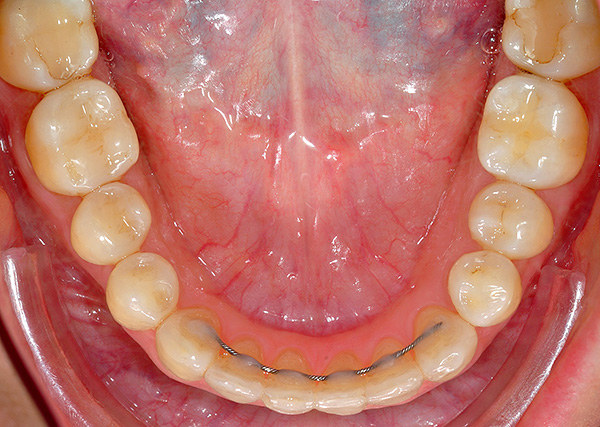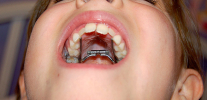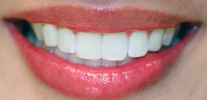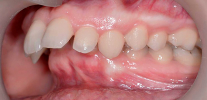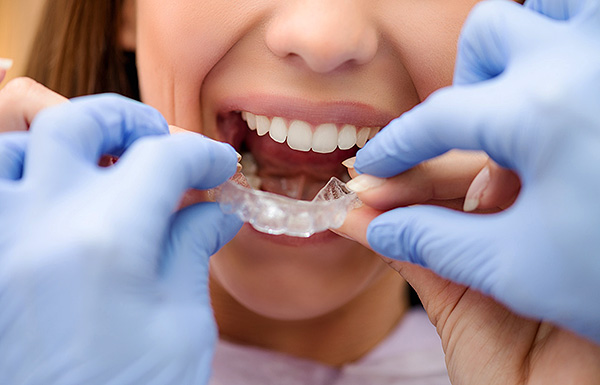
Many have heard about the use of cap by athletes to protect teeth, but not many know that today special orthodontic caps are also successfully used to correct the bite - both in childhood and in adulthood. Moreover, their effectiveness in correcting malocclusion in some cases is not inferior to bracket systems, that is, the same result is achieved in about the same time.
This device may look, for example, as a transparent overlay on the teeth, fitting tightly to them and almost repeating the shape of the dentition (with slight deviations that are specifically set by the doctor):
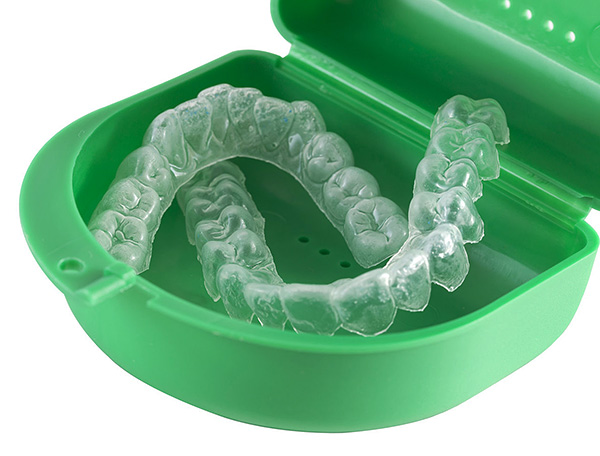
But this is far from the only option for a cap that allows you to correct the bite.
Let's see what types of orthodontic capes exist today, what their pros and cons are, and also talk about the nuances of using these devices at different ages.
Why is the condition of the jaw muscles so important for a proper bite and where does the mouthpiece
Orthodontists pay great attention to the condition of the muscles of the maxillofacial region of the patient, as their malfunctioning is often one of the causes of malocclusion. Normally, the muscles are in good shape, that is, almost relaxed, but at any time ready to work. So, it is important that when chewing, swallowing and talking, it is precisely those muscles that should work at the moment.
If there is an imbalance in the work of the maxillofacial muscles, then the usual actions can cause discomfort and pain (including headaches), in some cases forcing you to abandon solid foods and resort to frequent painkillers. Sometimes a person may not even understand why his head hurts so often. The bite also suffers greatly.
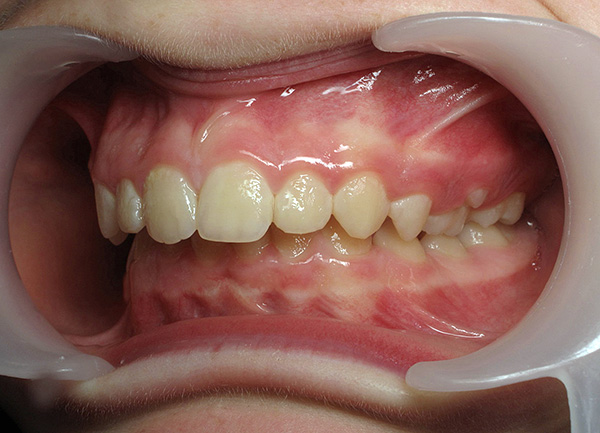
In such a situation, treatment on the bracket system can do more harm than good. Therefore, after examining the patient, doctors, if indicated, choose a treatment option with the use of special caps that, when worn regularly, relax the muscles and minimize the patient’s prerequisites for malocclusion.
In each case, orthodontic mouthguards are selected individually after a detailed examination of the patient.
In addition to muscle relaxation, you can also move your teeth to the correct position on the mouth guards, which further helps to smooth the bite. That is, in this case, the cap is able to perform partly the same function as the bracket system.
The photo below shows an example of orthodontic cap on the upper and lower jaw, a set of which the patient sequentially wears from the kit during the course of treatment, replacing each time the necessary intermediate result is achieved:
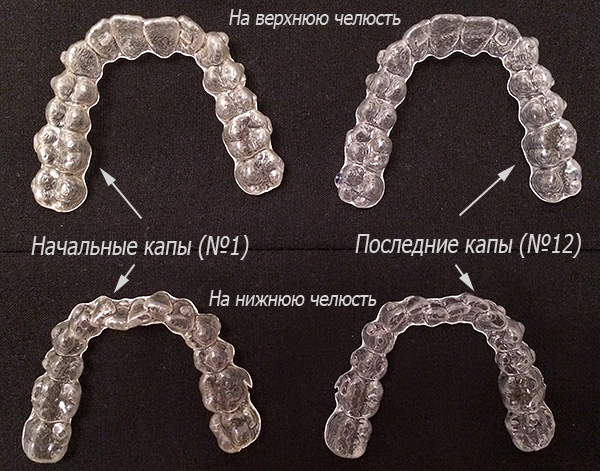
On average, the process of moving teeth to the final desired position takes several months, often more than a year. During this time, the muscles also manage to rebuild and become accustomed to changes in the dentition.
It is interesting
A case was registered when a mathematics student decided to independently correct his bite using the cap, which he made on a 3-D printer. He independently taught a print of his jaws, after which he calculated how much and in which direction he would need to move each tooth. Having thus obtained staged models of his jaws, the young man made mouth guards that he wore until he reached the desired position of the teeth.
With the help of a cap, it is possible to eliminate the most various pathologies in the state of the dentition:
- When one or several teeth are in the wrong position in the dentition (tilted, or are on the side, or above or below the normal position);
- In children - when it is necessary to even out the bite due to bad habits and (or) improper teething;
- In adults - with too large gaps between the teeth, or their crowding, or when, after tooth extraction, neighboring ones begin to lean toward the defect in the dentition;
- With a cross bite ...
And in many other cases. Often, treatment on the mouthguards is combined with the use of bracket systems - including to consolidate the results achieved.
Now let's get acquainted with the most popular varieties of orthodontic capes, which today are most often used in dental clinics.
Orthodontic Trainer System
A trainer is an apparatus that trains the muscles of the maxillofacial region (the word "trainer" in English means a simulator). This device is often prescribed for children with orthodontic treatment, and in this case, the emphasis is on training the maxillofacial muscles, and not on the active movement of the teeth.
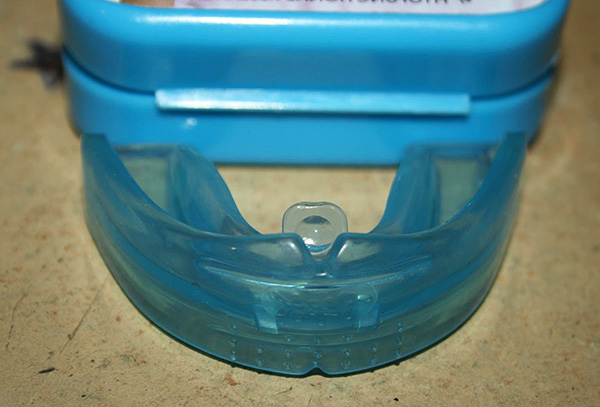
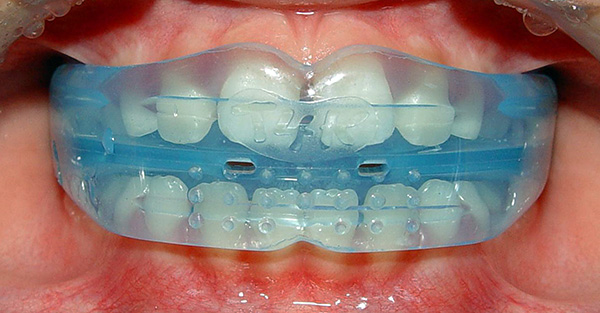
Indications for use of the device are:
- Mouth breathing;
- The habit of sucking fingers, lips, cheeks, foreign objects;
- Laying the tongue between the teeth and sucking it;
- The infantile type of swallowing - with this type of swallowing, the child strains the circular muscle of the mouth and bites his lower lip, as if imitating sucking. Thus, the lips and cheeks exert excessive pressure on the dentition, forcing the front teeth to deviate from the normal position;
- Distal bite, that is, when the upper teeth protrude excessively; ...
- As well as the front open bite. ...
The system of trainers is usually prescribed for children aged 2 to 5 years.
In fact, an orthodontic trainer is a silicone double-jaw splint (usually transparent). The photo below shows an example:
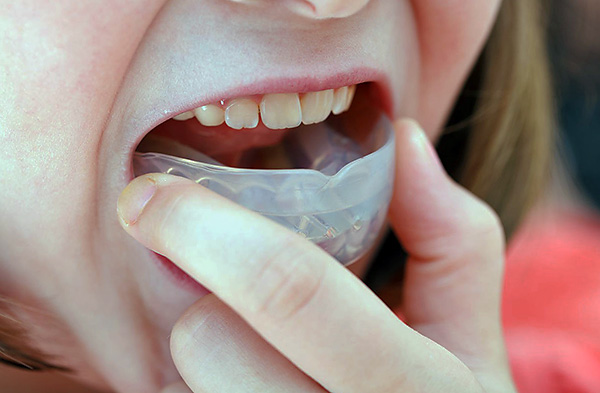
The trainer in its design has vestibular and oral shields, thereby preventing foreign objects from entering the child’s mouth and positioning the tongue in the correct physiological position. By moving the lips and cheeks away from the teeth, the device relaxes the tense muscles of the maxillofacial region. All this together helps to eliminate negative factors that violate the normal bite.
On a note
For those children whose doctor has determined the oral type of breathing, special openings are made in the mouth for air passage.
Contraindications to the use of orthodontic trainers are:
- The impossibility of nasal breathing (for example, with diseases of the ENT organs);
- Angle malocclusion III class (the so-called mesial bite);

- Cross bite.

The orthodontist appoints the mode of wearing the device, but on average the recommendations are the same - 2 hours during the day and at night, that is, the child should sleep with the trainer in the mouth.
On a note
During the adaptation period, you should wear a trainer for 10-15 minutes, gradually increasing the time until it is 2 hours.
Sometimes orthodontic trainers are also successfully used in adult patients during treatment on the bracket system, when the doctor sees the need to achieve balanced muscle work, prevent overload of the temporomandibular joint due to active tooth movement, and also when it is necessary to reduce treatment time by braces.
As with any other orthodontic appliances, to make the mouthguards and draw up a complete treatment plan, you must first obtain impressions of the jaws (or, as they sometimes say, take casts). For children, this can be a whole test because of a lack of understanding and ignorance of what is happening. A doctor with experience, of course, knows how to find an approach to a small patient, but sometimes it takes a lot of additional time and effort both of the orthodontist and parents, so you should prepare for this in advance.
Invisalign Eliners (Invisaline)
The Invisalign system of orthodontic appliances consists of a set of solid (rigid, non-silicone) drops, the number of which in the set for each patient can be different and is determined by the complexity of the pathology that needs to be fixed (the more drops, the longer the treatment will take).
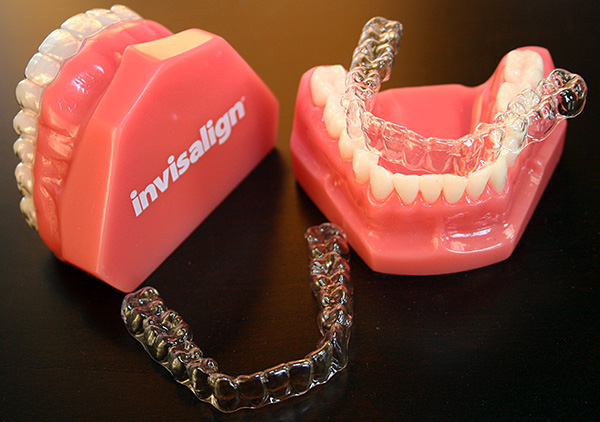
On a note
Eliner is a removable orthodontic apparatus in the form of a mouth guard. Inviseline lines are transparent, which makes them almost invisible on the teeth. The system developer is the American company Align Technology.
Today, the Invisiline orthodontic mouthguards are positioned as a complete replacement for bracket systems for most clinical cases. Indications for use are:
- crowding of teeth;
- too large gaps between the teeth;
- distal bite;
- open bite;
- cross bite;
- direct bite (upper and lower incisors close together with their cutting edges);
- and even the mesial bite (lower jaw protrudes forward relative to the upper).
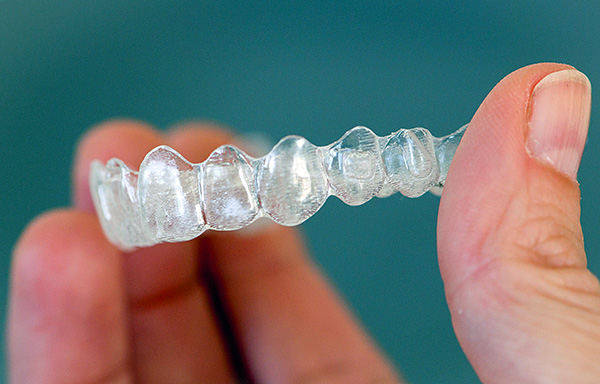
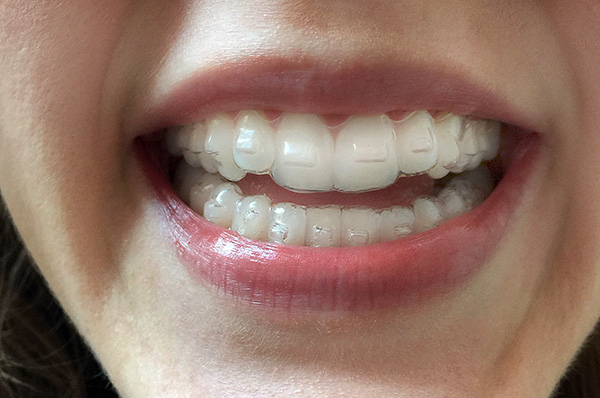
When compared with braces, then the orthodontic caps Invisiline really has a number of advantages:
- they are removable;
- less noticeable on teeth;
- do not impair diction;
- carry out their hygiene more convenient (just remove and clean);
- do not rub soft tissue of the oral cavity;
- treatment usually requires fewer visits to the orthodontist than treatment on bracket systems.
However, there are disadvantages:
- reduced heat resistance of Invisiline eliners (if hot water enters a solid transparent material, it is irreversibly deformed);
- still relatively low representation on the market (far from all clinics you can find the corresponding service);
- a large number of eliners in the kit complicates the treatment (in addition, often patients lose or damage individual mouthguards);
- since Invisiline is a removable orthodontic appliance, its use is suitable only for disciplined patients, otherwise the result will be poorly expressed (in practice, not all patients disciplinedly wear mouth guards exactly in the mode prescribed by the doctor);
- sometimes gluing to the teeth of the so-called retention points (hooks) is required - a trifle, but it can be unpleasant, especially when the mouth guard is removed, since such a hook can rub the mucous membrane of the cheeks.
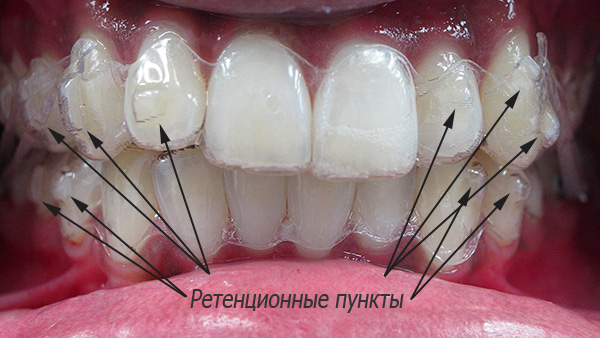
Now a few words about how the treatment is carried out with the use of Orthodontic caps Invisiline.
After examining the patient and determining the type of bite, a certified orthodontist who has been trained to work with the system draws up an upcoming treatment plan. Then impressions of the patient’s teeth are taken, a computer scan of the plaster models of the jaws is carried out - this is the 3D model of the jaws. This model is processed in a special computer program, and the doctor can immediately show the patient what the final result will be after treatment.
If the patient agrees to treatment, then the prints are sent to a laboratory in the United States together with the planned end result, which the orthodontist wants to achieve. In the laboratory, dental technicians model the movement of each tooth, sequentially making intermediate models of the jaws on a 3D printer - a whole set of such models is obtained, on each of which individual teeth are moved to a pre-calculated position, more and more close to the correct one.
As a result, for each intermediate model of the jaw, a mouthguard is made, the amount of which depends on the type of bite and the severity of the pathology with which the patient contacted.
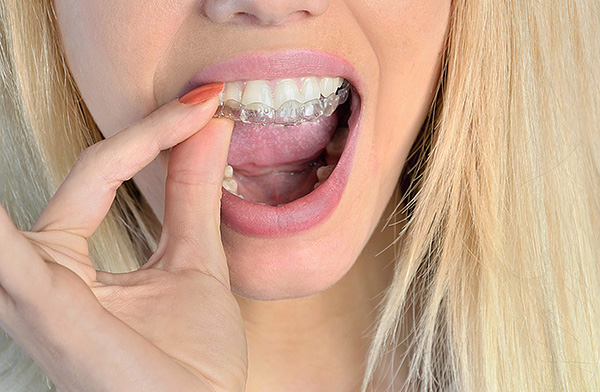
The cost of treatment with the use of Invisalign orthodontic appliances starts from about 170 thousand rubles. Prices can vary significantly - for example, depending on the level of the clinic.
From the practice of an orthodontist
Each mouthpiece should be worn for 2 weeks, then changed to the next.Many clinics give the patient 4 capes for two months at once to reduce the number of visits to the doctor. However, other clinics, on the contrary, schedule a visit every two weeks to make sure that the treatment is proceeding correctly.
It is worth noting that, judging by the reviews available on the Internet, not all patients who underwent treatment using Invisalign eliners were able to achieve the desired and predicted result by the doctor. Some patients after treatment with mouthguards had to wear a bracket system.
There are also less popular analogues of the Invisiline eliners on the market: Air Align, 3D Smile, OrthoSnap, Star Smile, etc. Today, transparent mouth guards can even be bought in pharmacies, but keep in mind that despite the assurances of advertising, such orthodontic appliances are applicable to all - not in all cases - in a number of clinical situations, surgical intervention and (or) treatment on the bracket system may be required.
Feedback:
“I was also treated on the Invisiline system. At first they sent 20 pairs of drops for each jaw. All is well, they are almost imperceptible, worn, as the doctor said. But when everything was over, it became clear that the bite did not even out to the end. Then the doctor and I took the casts again, another 15 pairs were sent to us. She wore them again for a long time. The result has become much better, but still imperfect. My doctor says that it’s my lower teeth that have so sharpened over the period of malocclusion. And that this is the best result that could be obtained ... "
Julia, Moscow
MyObrace system (Miobrace)
This bite correction system was developed by an Australian orthodontist, Dr. Chris Farrell. Initially, he created several types of cap data for various stages of the formation of a child’s bite, but today such devices are also used in adults.
Indications for use are the same as those of the orthodontic trainers described above. Recommended, including for night wear.
The photo below shows the initial MyObrace Starter baby cap:
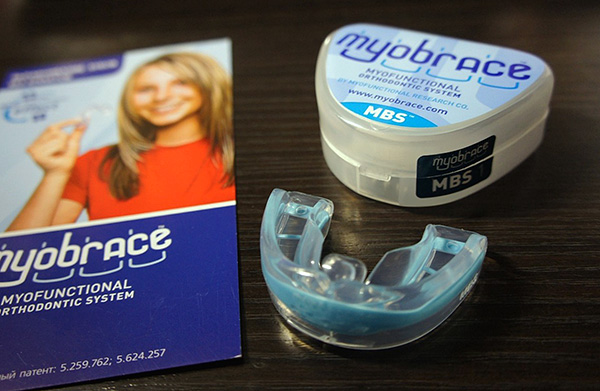
There are two modifications of the mouth guard: hard and soft. In the initial tray there are no cells for teeth, there is a lip bumper, a flap for the tongue - for putting it in the correct position. The task of this mouth guard is to achieve proper muscle function and fight against oral breathing.
An important structural element of the mouthpiece is the arc built into it to expand the dentition. The child's age for using the device is 8-12 years.
Another variety - MyObrace Core with a built-in arc (frame), is available in seven universal sizes and allows the doctor to accurately choose the right device for the child. A feature of this series is precisely the arc, which allows you to expand the dentition and build your teeth in the correct anatomical position. In this series of mouthguards, in addition to labial bumpers and flaps for the tongue, there are also special cells for each tooth - they, exerting a little pressure, gradually move the teeth, placing them evenly.
The device can be used during a shift and the beginning of a permanent bite, and, as the author of the system claims, the optimal age for using cap is 11-15 years.
Another variation - MyObrace No Core (MioBrace without an arc) - are used during the treatment period on the bracket system and are quite popular among orthodontists.
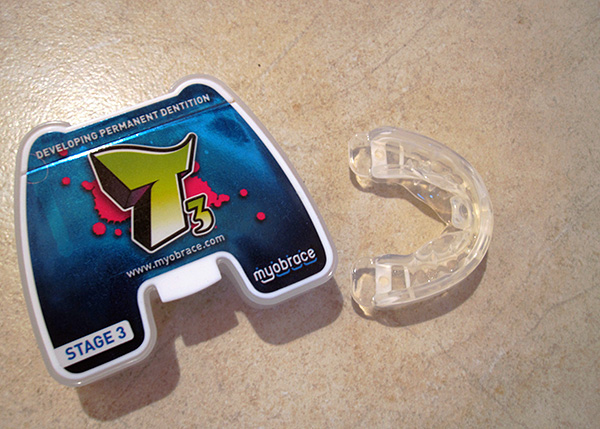
The use of such a mouth guard relaxes the maxillofacial muscles, weakens the load on the temporomandibular joint, corrects the position of the tongue and allows the braces to more fully and accurately work out the program laid down in them. These devices can also be used in the retention period, that is, after braces are removed - to maintain the achieved result.
Unfortunately, the presence of a mesial bite is an absolute contraindication to the use of the cap system MyObrace. Usually, this pathology of the bite requires complex treatment using combinations of fixed technique.
Feedback:
“I wore braces for two years, and after wearing them you need to fix the result. The doctor suggested that I use the MioBrace trainer, it’s such a two-sided burl, soft, does not scratch anything. I used to wear plates, but then I abandoned it. Inconveniently, it interferes in the mouth, I constantly want to remove it. But now I understand that the trainer is even more inconvenient to wear, and the plates are nothing compared to it. The trainer is large, the jaws are closed all the time, there is no way to talk with this contraption in the mouth, it is very inconvenient. But effective, good pressure from them is felt ... "
Oksana, Yekaterinburg
Orthodontic mouthguards with "rearrangement" of individual teeth
These devices are made by the orthodontist himself (not practiced in all clinics). As a rule, the decision on the use of such cap is made by the doctor and the patient together if, after treatment is completed on the bracket system, the patient experiences a relapse of the anomaly due to the release of the retainer.
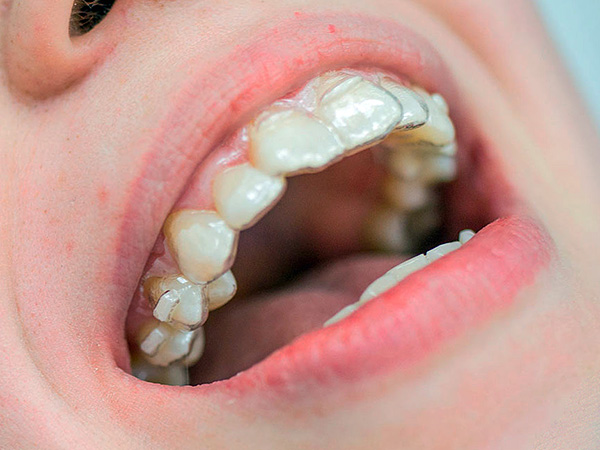
On a note
Retainer is an important orthodontic design, which is used after treatment on the bracket system and allows you to consolidate the result. If it is not used, then the teeth tend to return to their original wrong position.
The retainer is glued to the back of the dentition, so it is not visible to others. The doctor in the process of gluing always checks that the retainer does not interfere with the patient and does not bite him during chewing and talking, as this can lead to its detachment. If the retainer nevertheless comes unstuck, then the patient should immediately inform the doctor and soon get an appointment for gluing it.
Unfortunately, the retainer usually has to be worn for a very long time (3-6 years), and in some clinical cases, even for life.
So, many doctors additionally make mouthguards for the patient to prevent unwanted tooth movements.
If a lot of time has passed after using the bracket system, and the teeth have changed their position, then the mouth guards with the “rearrangement” of teeth are a kind of way out of the situation.
After receiving the impressions and making the gypsum model of the jaw, the orthodontist gently cuts out the desired tooth on the model and rearranges it to the best position, fixing it with wax. Then this model with the rearranged tooth is crimped in a special vacuum press - the heated acrylic plastic compresses the model under pressure. The resulting capa very accurately repeats the shape of the gypsum model.
The patient wears kapu for 2 weeks to move the teeth, then another 2 weeks to consolidate the result. After a month, if the desired result is not achieved, a new mouthguard is made. Sometimes this process can be quite lengthy, which requires a certain persistence, both from the attending physician and from the patient.
System of orthodontic shields and vestibular plates
In some cases, to normalize the bite in young children, a system of vestibular shields is used - they look like nipples, and the kids quickly get used to them. The use of a shield should wean a baby from the bad habit of pulling everything in his mouth.
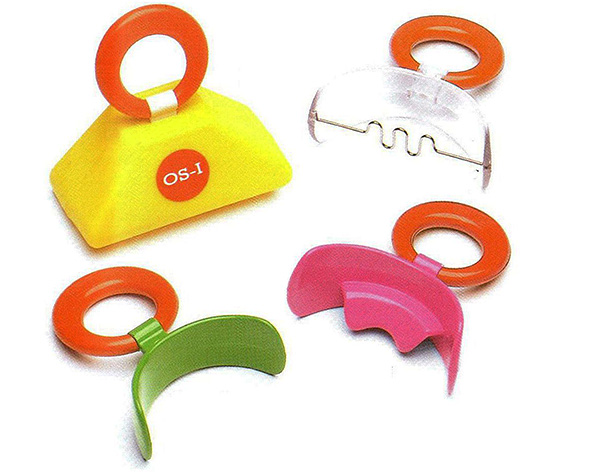
The design of the apparatus includes:
- Vestibular shield;
- Ring holder;
- Holes for breathing during the addictive period.
The mechanism of operation of such a mouth guard:
- Allows you to fight bad habits (sucking fingers and other foreign objects);

- Prevents biting of lips and cheeks;
- Limits excessive muscle pressure on the teeth;
- It delays the growth of the anterior segment of the lower jaw;
- Stimulates the growth of the posterior and lateral fragments of the jaw;
- Normalizes the function of closing the lips.
Indications for use:
- Prevention of open bite formation;
- Prevention of the formation of pathologies of I and II class according to Engle;
- Regulation of the functions of the lips and cheeks and the creation of myodynamic balance;
- Training circular muscles of the mouth.
From the practice of an orthodontist
To make the device, you need to take casts. Since young children are afraid, cry and break out, parents need to be there. When receiving impressions from very small doctors, orthodontists use a rigid silicone mass, which allows you to get a clear impression, even if the child is very uneasy.
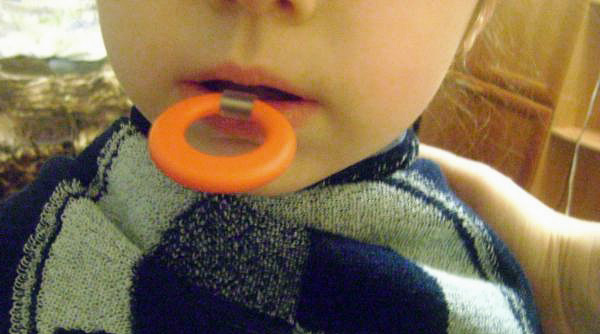
There are factory versions of such devices with various additional elements (for example, a shutter for the tongue), they are produced in several sizes. A ready-made vestibular shield orthodontist can pick up the child immediately.
Both when using a ready-made (standard) or individually made orthodontic tray, certain problems may arise. Devices can rub the child's mucous membrane of the mouth, lips and cheeks. Yes, and just can be unpleasant for the child to wear.
Many parents, seeing that the child is uncomfortable in the device, begin to feel sorry for him and simply allow him to wear the device less often. In this case, the effectiveness of treatment is sharply reduced. If it becomes clear that the edges of the device interfere and rub the child, then it makes sense to sign up to the orthodontist in the near future to fix the problem.
Treatment of TMJ diseases with cap
Diseases of the temporomandibular joint (TMJ) can manifest themselves in different ways, provoking:
- Muscle pain when talking, chewing;
- Headache;
- Abrasion of teeth;
- The phenomenon of "migration" of teeth - they tend to shift towards the resulting empty space, further violating the bite;
- Gum disease;
- Exposure of the necks of the teeth and their excessive sensitivity to cold or hot food;
- Subluxation of the joint can lead to jawbone and inability to completely close the mouth;
- Early tooth loss due to overstretching of the ligaments of the support-holding apparatus.
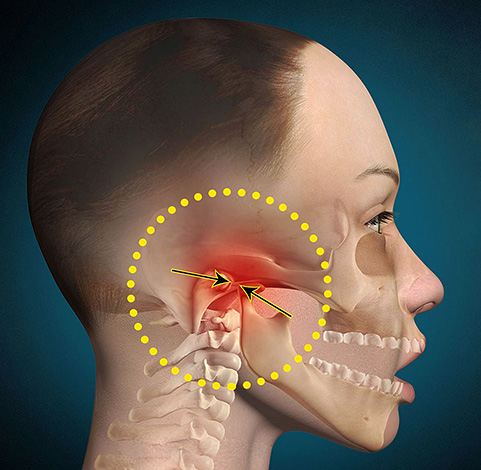
Often, patients turn to different doctors for help, but the proposed therapy does not bring relief.
One of the most effective treatment options for disorders of the temporomandibular joint is the so-called functional occlusal treatment using dissociating tooth splint (splint therapy).
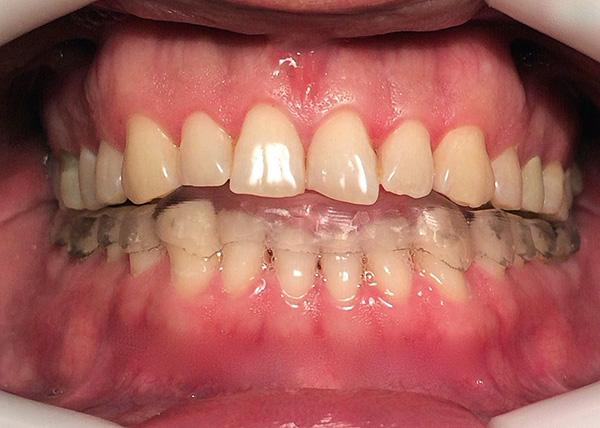
On a note
Splint is a special orthodontic mouthpiece made of hard plastic and covering one of the dentitions: either the upper or the lower. It has a thickness of not more than five millimeters and tightly grasps the edges of the dentition. Its purpose is to relax the muscles of the temporomandibular joint by separating the dentition.
As part of splint therapy, orthotic mouthguards are popular in neuromuscular dentistry today, allowing you to set the necessary bite height and keep the lower jaw in the correct position.
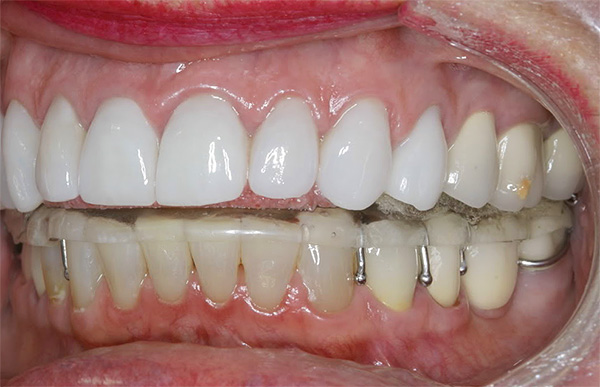
To achieve the best result, the doctor can also carry out the procedure of selective grinding of tooth enamel - with the help of a cutting tool, points on the teeth that can be an obstacle to the correct movements of the jaws are gently polished.
Splint should be worn both day and night, removing only with food. At first, the patient may experience discomfort from the use of mouthguards, pulling pains in the muscles. But if the mode of wearing the tire is respected, the discomfort gradually disappears, and with them the severity of the pathology from the TMJ decreases. Some patients note that after getting used to the tire they feel uncomfortable without it.
In conclusion, it is worth noting that along with the technologies and methods described above, today there are many similar systems, both domestic and foreign companies. The orthodontist himself chooses for himself which system is more convenient for him to work with. Therefore, if suddenly in one clinic you were told that in your situation the bite can be corrected only with the help of a bracket system, this does not mean that in another clinic the same problem will not be taken to fix on orthodontic burls.
Conversely, one doctor may insist on using a cap system, while another specialist will only shake his head and say that cap is an ineffective technology, and only braces will correct the situation.
Be that as it may, choose not just technology, but first of all a good experienced doctor, follow his recommendations - and you will certainly achieve the desired result.
Be healthy!
Video review of perepetov when correcting the bite on the eliners
A clear result of treatment on Inviseline lines

